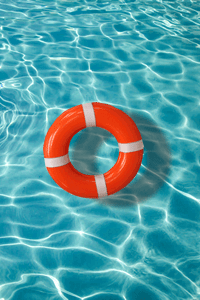Leadership Lessons from Lifeguards
By Wendy Claussen-Schoolmeester Communicator June 2014, Volume 37, Issue 10 This past summer, my daughter and I headed to the swimming pool to relax in the sun. It was a warm, restful, mostly uneventful day.
By Wendy Claussen-Schoolmeester
Communicator
June 2014, Volume 37, Issue 10
 This past summer, my daughter and I headed to the swimming pool to relax in the sun. It was a warm, restful, mostly uneventful day.
This past summer, my daughter and I headed to the swimming pool to relax in the sun. It was a warm, restful, mostly uneventful day.
The pool was filled with children of all ages. Moms and babies splashed at the zero-depth end and tweens did cannon-balls off the diving board at the deep end. Lifeguards, seated high in their chairs around the pool, scanned the water for any possible mishaps.
At one point, the lifeguard seated closest to us blew his whistle and jumped into the three-foot deep water. A young child had wandered into water that was too deep. All the other lifeguards stood in their chairs and blew their whistles continuously to warn each other and the swimmers that there was a possible emergency.
After the child’s rescue, it dawned on me that lifeguards and principals have a lot in common. Here’s how.
- Lifeguards prepare for the job. Lifeguards arrive early and prepare for their day. They organize necessary equipment prior to taking their assigned post. Dynamic principals also arrive at school early and keep an organized schedule that they check diligently and then prioritize. To further prepare for the job, principals improve their skills by attending workshops and conferences. In both the pool and at school, leaders know that preparation prevents poor performance.
- Lifeguards are visible. Lifeguards sit high above the water and are visible to all pool patrons. The same should be true for principals: A great principal is visible to the students and the staff by being present in the hallways, in the classrooms, and in the lounge. Principals should hold a “MBWA degree,” or “Management by Walking Around.”
- Lifeguards ensure safety of all patrons. Lifeguards focus on the patrons of the swimming facility and constantly survey the pool. Patrons’ safety is of utmost importance. Principals, too, focus on the well-being of students and staff. The principal ensures a safe environment by openly communicating with students and staff, and actively listening to their comments and concerns.
- Lifeguards remain calm in an emergency. Outstanding lifeguards are able to react calmly and effectively in any situation. To stay cool-headed, lifeguards practice the skills required to save lives. The whistle becomes their life-saving tool. Outstanding principals must do this, too. In emergency situations, principals must remain calm. They must keep a cool head when breaking up a fight or negotiating a dispute. Plus, to keep students and staff safe, principals must organize and lead tornado and lock-down drills.
- Lifeguards apply appropriate discipline. Lifeguards are knowledgeable about the rules and regulations of the aquatic facility, and they manage patron behavior by enforcing them. Principals, too, must discipline appropriately. Principals participate in the strategic planning of the schoolwide discipline policy, and then they must consistently support teachers when enforcing the expectations.
- Lifeguards document and report. Lifeguards are required to fill out all necessary paperwork that follows facility protocol. Competent lifeguards report if a patron is allowed to swim in the deep end, or document if a patron skinned a knee while in the aquatic facility. Similarly, principals are expected to document, document, document. Principals document teacher performance, data for grades, discipline issues, Title reports, and many other items.
- Lifeguards wear many hats. When the lifeguards are not manning their posts, they perform other duties, such as cleaning bathrooms, selling pool passes, or assisting in the concession stand. Principals, as well, wear many hats during the day. Principals may assist custodians with water leaks, shovel snow after a blizzard, sub in a classroom if a teacher has an emergency, check on the sick child who shows up in the nurse’s office and the nurse is at the other building, help kindergarteners open their milk cartons, and chaperone the student section at the basketball game—and more!
- Lifeguards maintain high standards. Lifeguards should project a positive attitude at all times and care for each patron. Excellent principals do the same. They expect the best of their students, their staff, and most importantly, themselves. They strive to positively model best practices. Principals dress professionally, act professionally, and truly care about each person in the school building.
Once the rescue was over, the lifeguards went back to surveillance and my daughter and I went back to chatting and soaking up the sun’s rays, both a little wiser. These leadership lessons from lifeguards have direct applications for anyone in a leadership position. Keep these eight practices in mind as you go about your day, and remember that putting strong leadership principles into practice—whether in the pool or in your school—can create a positive ripple effect with your colleagues.
Wendy Claussen-Schoolmeester, a former principal, is a professor of education at Southwest Minnesota State University.
—
Copyright © 2014. National Association of Elementary School Principals. No part of the articles in NAESP magazines, newsletters, or website may be reproduced in any medium without the permission of the National Association of Elementary School Principals. For more information, view NAESP’s reprint policy

